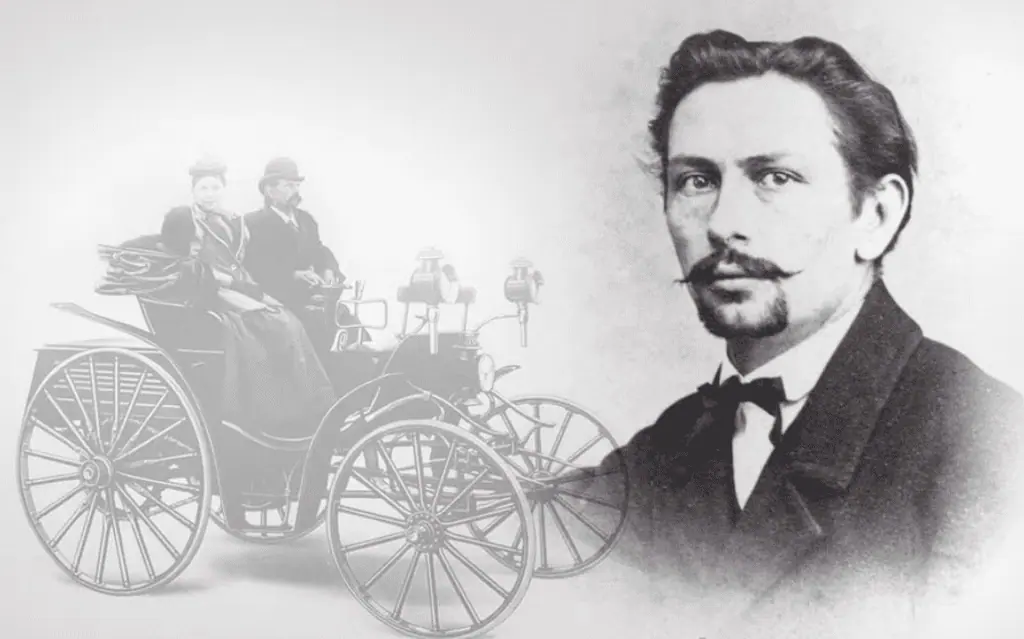
Carl Benz (Image: Mercedes-Benz)
By David Benjamin
I recently memorized what I call the “military alphabet,” officially known as the NATO phonetic alphabet. This is a series of words that serve as a universal radio code for each letter of the Roman alphabet. Since 1956, this set of 26 words, used in spoken communication in military intercom, in radio communications and in air traffic control is: Alfa, Bravo, Charlie, Delta, Echo, Foxtrot, Golf, Hotel, India, Juliett, Kilo, Lima, Mike, November, Oscar, Papa, Quebec, Romeo, Sierra, Tango, Uniform, Victor, Whiskey, X-ray, Yankee, Zulu.
I struggled to swiftly recall each mnemonic until, while driving, I started practicing with license plate numbers, most of which combine letter (usually three) and number groups (three or four). Now, when I’m behind a car with AMH on the plate, I think — or say out loud — “Alfa Mike Hotel.” Or, I glimpse a parked car whose ID ends with PRT: “Papa Romeo Tango.”
I googled this wonderfully esoteric topic and discovered that the NATO phonetic alphabet derived from exhaustive research to single out sounds that the human ear could most readily discern despite extraneous noise, a static-marred transmission or intervening chatter. I was fascinated to learn that, to make the final cut, Alfa beat out Able, and Bravo supplanted Baker. Among other defeated candidates were Casablanca, Havana, Jerusalem, Neufchatel (really?), Liverpool and Zurich, along with Peter, Nancy and Otto.
The genius of this alphabet is its clarity. I’ve taken to using it on the phone with call centers whose staff are often speakers of English as a second language (Echo Sierra Lima). These code words reduce misunderstandings because each literally snaps off the tongue and into the ear of the listener. They engage senses in the ear (hearing) and on the tongue (feel) and implicate a third (sight). You can’t say Tango or Foxtrot without seeing, in your mind’s eye, dancers. And when I say “Yankee” I think Jimmy Cagney, Yogi Berra, Aaron Judge.
Best of all, because I can feel their friction, these words are fun to say.
Because I do this while driving, I ponder how cars have, throughout my life, engaged my senses. Among the most sensual of all my rides was a 1966 Ford Econoline van named Rosemary.
Most people born since, say, 1960, have never seen a manual choke, which is a beautiful device, a hypodermic that regulates fuel flow to the carburetor.
From left to right, Rosemary’s minimalist dashboard displayed speedometer, odometer and a primitive engine-temp dial, then the choke —
Wait. Most people born since, say, 1960, have never seen a manual choke, which is a beautiful device, a hypodermic that regulates fuel flow to the carburetor. On a subzero morning in Wisconsin, when every engine left outdoors is moribund, a little extra juice is the elixir of life. With the right touch on the choke, the operator can add the trickle that turns the trick. But carefully! The human relationship with a manual choke is subtle and capricious. Nurse it out gently. Try the ignition. Not yet? Okay, one more millimeter. Not too far! Oh no! Now you’ve flooded it. Go back inside. Have another coffee. Wait for gravity to deal with all that extra gas. And next time? Gently!
Rosemary’s manual choke was like everything else — cigarette lighter, heater control, AM radio — in that utilitarian row of buttons, dials and knobs. Their common denominator was tactility. They were few and simple. You knew each by touch and you worked them without looking. Eyes on the road.
In the advent of electronic “software defined vehicles” (Sierra Delta Victor) and ultimately robocars, we’re witnessing the demotion of the senses.
Of course, Rosemary had powers to engage my every sense. The V-6, positioned literally at my elbow, communicated by ear with “funny sounds” and by nose with abnormal odors. When a radiator pinhole popped, I could taste Prestone on my tongue.
Now, of course, we’re designing cars in which the driver is hermetically isolated from the smells and sounds of the engine — which might now be electric and literally noiseless. The alleged driver has no feel for the machine and precious little to feel. A touchscreen, after all, is barely tactile. It does not gratify the senses like a knob or a serrated dial. There’s nothing to punch, twist, yank or choke.
In the advent of electronic “software defined vehicles” (Sierra Delta Victor) and ultimately robocars, we’re witnessing the demotion of the senses. Carmakers, driven to add ever more features, have contrived to banish from the driver’s seat experience, what Carl Benz a century ago would have called fingerspitzengefühl. And they are testing whether every driver is willing — even able — to adapt to a kibitz-intensive cockpit bristling with displays, flashing lights, beeps, buzzers, sensors, spycams and wake-up klaxons that turns him or her from the “master of my fate, the captain of my soul” to little more than “safe” but insensate cargo.
David Benjamin, an author, essayist and veteran journalist, has been examining the human element in high technology for more than 20 years. His novels and non-fiction books, published by Last Kid Books, have won more than a dozen literary awards. Most recently, his coming-of-age novel, They Shot Kennedy, had won the 2021 Midwest Book award in the category of literary/contemporary/historical fiction.
Copyright permission/reprint service of a full TechSplicit story is available for promotional use on your website, marketing materials and social media promotions. Please send us an email at [email protected] for details.
